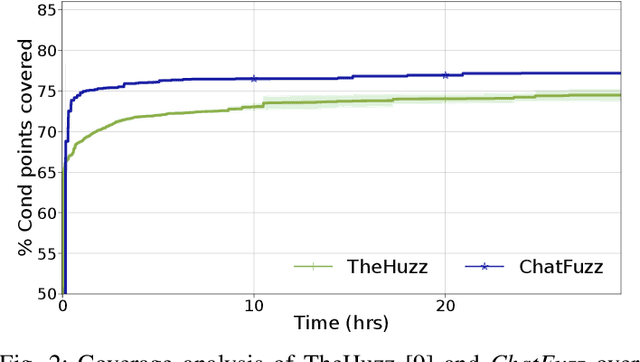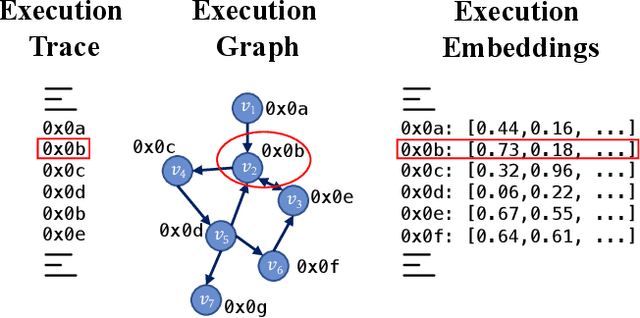Marco Chilese
Beyond Random Inputs: A Novel ML-Based Hardware Fuzzing
Apr 10, 2024

Abstract:Modern computing systems heavily rely on hardware as the root of trust. However, their increasing complexity has given rise to security-critical vulnerabilities that cross-layer at-tacks can exploit. Traditional hardware vulnerability detection methods, such as random regression and formal verification, have limitations. Random regression, while scalable, is slow in exploring hardware, and formal verification techniques are often concerned with manual effort and state explosions. Hardware fuzzing has emerged as an effective approach to exploring and detecting security vulnerabilities in large-scale designs like modern processors. They outperform traditional methods regarding coverage, scalability, and efficiency. However, state-of-the-art fuzzers struggle to achieve comprehensive coverage of intricate hardware designs within a practical timeframe, often falling short of a 70% coverage threshold. We propose a novel ML-based hardware fuzzer, ChatFuzz, to address this challenge. Ourapproach leverages LLMs like ChatGPT to understand processor language, focusing on machine codes and generating assembly code sequences. RL is integrated to guide the input generation process by rewarding the inputs using code coverage metrics. We use the open-source RISCV-based RocketCore processor as our testbed. ChatFuzz achieves condition coverage rate of 75% in just 52 minutes compared to a state-of-the-art fuzzer, which requires a lengthy 30-hour window to reach a similar condition coverage. Furthermore, our fuzzer can attain 80% coverage when provided with a limited pool of 10 simulation instances/licenses within a 130-hour window. During this time, it conducted a total of 199K test cases, of which 6K produced discrepancies with the processor's golden model. Our analysis identified more than 10 unique mismatches, including two new bugs in the RocketCore and discrepancies from the RISC-V ISA Simulator.
One for All and All for One: GNN-based Control-Flow Attestation for Embedded Devices
Mar 12, 2024



Abstract:Control-Flow Attestation (CFA) is a security service that allows an entity (verifier) to verify the integrity of code execution on a remote computer system (prover). Existing CFA schemes suffer from impractical assumptions, such as requiring access to the prover's internal state (e.g., memory or code), the complete Control-Flow Graph (CFG) of the prover's software, large sets of measurements, or tailor-made hardware. Moreover, current CFA schemes are inadequate for attesting embedded systems due to their high computational overhead and resource usage. In this paper, we overcome the limitations of existing CFA schemes for embedded devices by introducing RAGE, a novel, lightweight CFA approach with minimal requirements. RAGE can detect Code Reuse Attacks (CRA), including control- and non-control-data attacks. It efficiently extracts features from one execution trace and leverages Unsupervised Graph Neural Networks (GNNs) to identify deviations from benign executions. The core intuition behind RAGE is to exploit the correspondence between execution trace, execution graph, and execution embeddings to eliminate the unrealistic requirement of having access to a complete CFG. We evaluate RAGE on embedded benchmarks and demonstrate that (i) it detects 40 real-world attacks on embedded software; (ii) Further, we stress our scheme with synthetic return-oriented programming (ROP) and data-oriented programming (DOP) attacks on the real-world embedded software benchmark Embench, achieving 98.03% (ROP) and 91.01% (DOP) F1-Score while maintaining a low False Positive Rate of 3.19%; (iii) Additionally, we evaluate RAGE on OpenSSL, used by millions of devices and achieve 97.49% and 84.42% F1-Score for ROP and DOP attack detection, with an FPR of 5.47%.
ARGUS: Context-Based Detection of Stealthy IoT Infiltration Attacks
Feb 16, 2023Abstract:IoT application domains, device diversity and connectivity are rapidly growing. IoT devices control various functions in smart homes and buildings, smart cities, and smart factories, making these devices an attractive target for attackers. On the other hand, the large variability of different application scenarios and inherent heterogeneity of devices make it very challenging to reliably detect abnormal IoT device behaviors and distinguish these from benign behaviors. Existing approaches for detecting attacks are mostly limited to attacks directly compromising individual IoT devices, or, require predefined detection policies. They cannot detect attacks that utilize the control plane of the IoT system to trigger actions in an unintended/malicious context, e.g., opening a smart lock while the smart home residents are absent. In this paper, we tackle this problem and propose ARGUS, the first self-learning intrusion detection system for detecting contextual attacks on IoT environments, in which the attacker maliciously invokes IoT device actions to reach its goals. ARGUS monitors the contextual setting based on the state and actions of IoT devices in the environment. An unsupervised Deep Neural Network (DNN) is used for modeling the typical contextual device behavior and detecting actions taking place in abnormal contextual settings. This unsupervised approach ensures that ARGUS is not restricted to detecting previously known attacks but is also able to detect new attacks. We evaluated ARGUS on heterogeneous real-world smart-home settings and achieve at least an F1-Score of 99.64% for each setup, with a false positive rate (FPR) of at most 0.03%.
Follow Us and Become Famous! Insights and Guidelines From Instagram Engagement Mechanisms
Jan 17, 2023



Abstract:With 1.3 billion users, Instagram (IG) has also become a business tool. IG influencer marketing, expected to generate $33.25 billion in 2022, encourages companies and influencers to create trending content. Various methods have been proposed for predicting a post's popularity, i.e., how much engagement (e.g., Likes) it will generate. However, these methods are limited: first, they focus on forecasting the likes, ignoring the number of comments, which became crucial in 2021. Secondly, studies often use biased or limited data. Third, researchers focused on Deep Learning models to increase predictive performance, which are difficult to interpret. As a result, end-users can only estimate engagement after a post is created, which is inefficient and expensive. A better approach is to generate a post based on what people and IG like, e.g., by following guidelines. In this work, we uncover part of the underlying mechanisms driving IG engagement. To achieve this goal, we rely on statistical analysis and interpretable models rather than Deep Learning (black-box) approaches. We conduct extensive experiments using a worldwide dataset of 10 million posts created by 34K global influencers in nine different categories. With our simple yet powerful algorithms, we can predict engagement up to 94% of F1-Score, making us comparable and even superior to Deep Learning-based method. Furthermore, we propose a novel unsupervised algorithm for finding highly engaging topics on IG. Thanks to our interpretable approaches, we conclude by outlining guidelines for creating successful posts.
 Add to Chrome
Add to Chrome Add to Firefox
Add to Firefox Add to Edge
Add to Edge